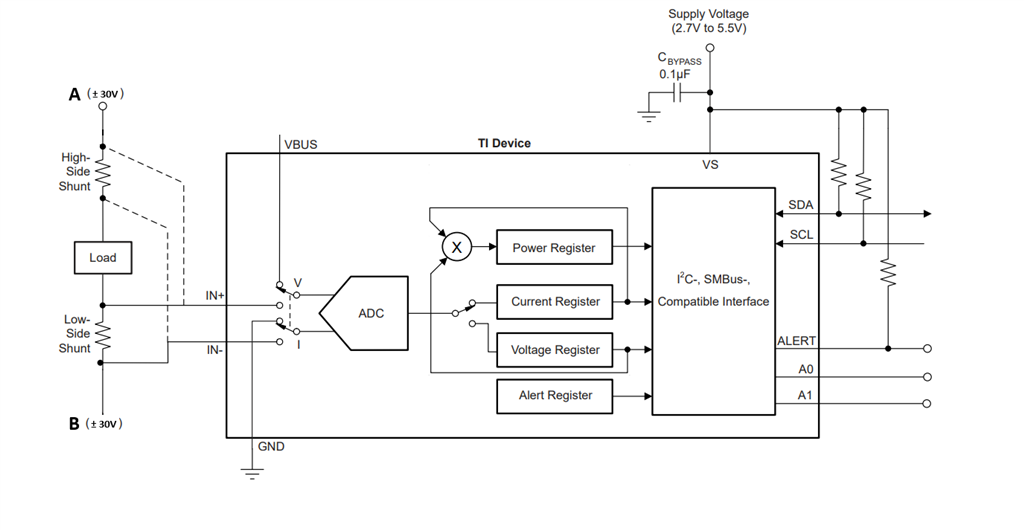- Ask a related questionWhat is a related question?A related question is a question created from another question. When the related question is created, it will be automatically linked to the original question.
This thread has been locked.
If you have a related question, please click the "Ask a related question" button in the top right corner. The newly created question will be automatically linked to this question.
Tool/software:
Hi Everyone,
I need to measure DC current bidirectional max ± 10A and searching best solution about it.My accuracy need to ± 5 ma.
Now i don t need to voltage measurement .
My circuit working like below,
A point 25V DC B point -25V DC or A point -10V B point +20V but their reference ground not referenced ina226 gnd.In other words ina226 gnd different from shunt ground.
INA226 working like this scenario?
Best Regards.
Hello Ismail,
Thank you for using the TI forum. The ground of the shunt and the ground of the INA do need to be the same. In a system where you need the ground of the shunt different from the ground of the MCU, you have a few options:
1. You can use a digital isolator between the INA and the MUC, as done in this reference design: https://www.ti.com/tool/TIDA-01608. Since your common mode voltage is not above the device max voltage, you would not need the voltage divider to the VBUS pin.
Note that when using a digital isolator, make sure the one you use works with the voltage logic levels (including logic low levels) of the INA you use (and note that many isolators have different specs for each side).
2. You could use a Hall effect based current sensor, such as these: https://www.ti.com/sensors/magnetic-sensors/hall-effect-current/products.html, which have built in isolation.
3. There are also isolated ADC's that you can use, such as these: https://www.ti.com/isolation/isolated-adcs/products.html
Regards,
Mitch
Dear Mitch,
Thank for your sugestions.I want to add some details about my project.My project goal my two inputs may change over time ± 30V.
My project working with battery and low power , so opamp supply not exceed ±5V.Now i found INA149 Comman Mode Voltage ±275V,so can i apply -30V DC and 0V (potential ground different from INA) measure current over shunt ?
Hey Ismail,
No, that won't work because if the grounds are different then you don't know the potential difference between the two. For example, even though the battery is at -30V compared to its ground, it may not be within limit of the INA compared to its ground. Because of this, you will need some isolation.
Sorry, I missed that the load was at ±30V and changing.Because of this, option 1 above for you will not work because it will be hard to get a voltage to power the INA. So, you would need to use option 2 or 3. Also, for option 3, there are isolated amplifiers as well, https://www.ti.com/isolation/isolated-amplifiers/overview.html (if you prefer those over the adcs: https://www.ti.com/isolation/isolated-adcs/overview.html). If you look at these two links, you would want to pick one with a single supply that has the shunt side powered from the the other side. this way you don't have to try to create a voltage from your ±30V to power the isolated side. (here is an example: https://www.ti.com/product/AMC3306M05).
Regards,
Mitch